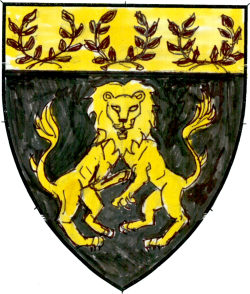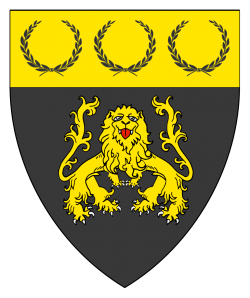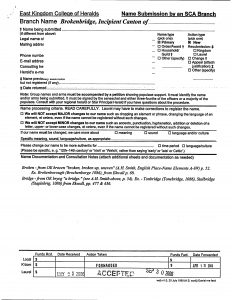Lions End is Østgarđr’s easternmost branch, covering Nassau County.
 Canton of Lions End
Canton of Lions End
The canton’s name was submitted in July 1988, and accepted in October.
The note clarifies that the name does not contain an apostrophe:
Please note: Lions End is a place where lions go to meet. It is not what they sit upon when they sit down to eat. (I.e. it’s Lions plural not Lion’s possessive.) Lions was chosen during a naming binge to try to connect ourselves to our mundane geographic area, and is vaguely derived from Long Island (and various anagrams). The choice of the word End comes from our neighbors to the east An Dubhaigeainn (which translates to Abyss) and so we figured that before you get to the abyss you have to come to an end, and so “Lions End.”
Some additional commentary was added at the kingdom level to support this name, which received a mixed review in the LoAR when approving it for registration:
Although the analogue with Land’s End made on the letter of intent is not really accurate, the name is acceptable.
The distinction is routinely overlooked. For example, when the canton registered its arms in 1990 the acceptance was listed under the name “Lion’s End,” and only corrected sixteen years later. (Indeed as of this writing, the canton’s web site uses the apostrophe in the site’s title and home page, although elsewhere it uses the registered version.)

Azure, a bicorporate lion within a laurel wreath Or. (Returned)
The canton’s initial selection of arms featured a bi-corporate lion, an unusual charge featuring a lion’s head with two bodies attached to it.
It was returned in May 1989 with the note:
Conflict with the arms of John of Northampton, Mayor of London in 1381–83 (“Azure, a bicorporate lion guardant crowned Or.”). As Crescent has noted, this is a frequently depicted piece of armoury. Indeed, it is almost the “defining instance” for the bicorporate lion in most handbooks.
Although the rules have changed since, at the time the Society’s rules for armory conflict included checking against the arms issued by other jurisdictions, including medieval England.

Sable, a bicorporate lion and on a chief Or, three laurel wreaths sable.
A revised version of the device was submitted a few months later, and approved in May of 1990 without comment.
 The lion is an allusion to the mundane county of Nassau, which has as its arms “azure, a lion rampant between seven billets Or,” which is derived from the arms of the European house of Nassau, “azure billetty, a lion rampant Or armed and langued gules.”
The lion is an allusion to the mundane county of Nassau, which has as its arms “azure, a lion rampant between seven billets Or,” which is derived from the arms of the European house of Nassau, “azure billetty, a lion rampant Or armed and langued gules.”

An attractive depiction of the arms is provided by canton’s heraldic banner.
 Sable, a bicorporate lion and on a chief Or, three laurel wreaths vert. (Error)
Sable, a bicorporate lion and on a chief Or, three laurel wreaths vert. (Error)
Due to a scribal transcription error around that time, the arms listed in the Society’s armorial database differ from the registration in the tincture of the laurel wreaths, which were listed as vert instead of sable. [Edited May 23: the correction was rolled out in today’s database update and it is now listed correctly as three laurel wreaths sable.]
As a result, a number of illustrations of the branch’s arms which were taken from that blazon have been drawn incorrectly, including the version that’s currently shown on the canton’s home page, as well as the East Kingdom wiki and other places.
Following the discovery of this error, the O&A is currently being adjusted to match the original registration.
[Edited June 17: Local oral history holds that the wreaths were changed to green because of a ruling at the time that all laurel wreaths must be vert. However, the lack of commentary in the LoAR which accepted the arms with sable wreaths, and the contemporaneous registration of numerous wreaths of other tinctures, suggests that this is post-facto mythologizing — this really was due to a simple scribal error during data entry.]

A bicorporate lion atop a billet fesswise Or.
The canton submitted a populace badge in mid-2013, which was registered that November.
It features the same bicorporate lion as in the branch arms, standing on a billet (the heraldic term for a rectangle).
According to Yehuda ben Moshe, canton herald at the time, the initial intention was to register just a fieldless bicorporate lion Or, which members of the populace had already begun using as an informal populace badge. However, this was found to be too similar to another registration, the holder of which declined to grant permission to conflict, and so they looked for something simple that could be added to existing badges and settled on a billet, which is another design element present in the aforementioned arms of Nassau County.
For the curious, the territory of Lions End was previously home to the Canton of Mandan, sometimes spelled Madnan, which was formed in October 1980, had its name registered in January 1983, went defunct in May 1985, and had its name released in a December 1989 purge of defunct East Kingdom branches, according to Lord Richard the Poor’s “A Geographic History of the East Kingdom” and the Society’s armorial records. The name may have been an allusion to “Madnan’s Neck,” a seventeenth-century name for the Great Neck region, derived from “Menhaden-Ock,” its native Mattinecock name, itself a reference to the small Menhaden fish then plentiful in the region.











